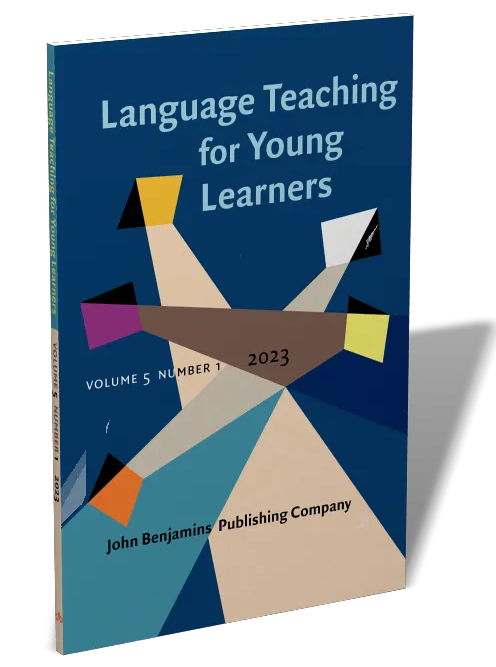Language Teaching for Young Learners
2023年第1期目录及摘要
TABLE OF CONTENTS
EDITORIAL
Janet Enever | pp. 1–6
ARTICLES
L1 use and patterns of interaction of young EFL learners in a collaborative writing task
Agurtzane Azkarai | pp.7-29
The affordances of an intercultural e-portfolio: A case study on perspectives of English teachers in Norway
Anastasia Hanukaev | pp.30-58
ELT coursebooks for primary school learners: A comparative analysis of songs
Mei Peng, Yangyang Shi & Ping Zhang l pp. 59-84
Extramural English for early language learning: A blessing or a curse?
Signe Hannibal Jensen & Jørgen T. Lauridsen | pp. 85-109
BOOK REVIEWS
Stefanie Frisch & Jutta Rymarczyk (Eds.). 2021. Current Research into Young Foreign Language Learners’ Literacy Skills
Reviewed by Yvonne Knospe | pp. 110-113
Annika Kolb & Marita Schocker. 2021. Teaching English in the Primary School. A Task-Based Introduction for Pre- and In-Service Teachers
Reviewed by David Valente | pp.114-118
ABSTRACTS
L1 use and patterns of interaction of young EFL learners in a collaborative writing task
Agurtzane Azkarai
Universidad del País Vasco/Euskal Herriko Unibertsitatea (UPV/EHU)
Research on L1 use among young EFL learners is scarce and has been mainly conducted with oral tasks, while collaborative writing (CW) tasks have been underexplored. CW provides learners with many opportunities for L2 development, especially when they work in collaborative patterns of interaction. In research with young EFL learners, the relationship between L1 use, CW and patterns of interaction has not been studied yet, and it is important to assess the extent to which the patterns of interaction formed in CW tasks play a role in L1 use by these learners, because these three factors have been claimed to impact L2 development. Thus, this study examines whether the patterns of interaction formed played a role in the L1 use and functions of 56 young EFL learners while they worked on a CW task at two different times. The findings indicated that these EFL learners showed mainly parallel/passive or collaborative patterns of interaction at both testing times, that the L1 was used mainly for metacognitive issues, although differences existed from pattern to pattern, and that a collaborative pattern of interaction resulted in more L1 use. The results are discussed following the pedagogical implications of these findings for the EFL classroom.
Keywords: L1 use, patterns of interaction, young learners, collaborative writing, EFL
The affordances of an intercultural e-portfolio: A case study on perspectives of English teachers in Norway
Anastasia Hanukaev
University of Stavanger
This paper explores teachers’ perceptions of the affordances of an e-portfolio of intercultural competence (EPIC). The EPIC was implemented during an 8-week intervention carried out in a Norwegian lower secondary school. Data were collected from various sources (e.g., learners’ texts, focus group interviews), but this paper draws on the data from three individual teacher interviews conducted in the spring semester 2018. This study extends our understanding of the way an e-portfolio can be integrated into the English as a foreign language (EFL) classroom as a tool for promoting intercultural competence. The findings underscore the affordances of the e-portfolio to track the learners’ reflections on their own complex selves and others; moreover, the use of the e-portfolio enabled the teachers to create flexible and varied learning spaces, which in turn provided opportunities for intercultural language learning. Pedagogical implications are provided on how foreign language (FL) teachers might support intercultural competence development through the use of the e-portfolio.
Keywords: e-portfolio, affordance, intercultural learning, foreign language teaching
ELT coursebooks for primary school learners: A comparative analysis of songs
Mei Peng and Yangyang Shi and Ping Zhang
Shanghai International Studies University | Shanghai International Studies University | Shanghai Changning Institute of Education
This article reports on the findings of a comparative study on songs in four English coursebook series for primary school learners, with two published in China and another two in the UK. Detailed analysis focuses on the number, the coverage, the teaching purposes, and the instructional arrangements of songs. The findings show that although the total number of songs in coursebooks from China outnumbers that from the UK, no correlation exists between learners’ grade levels and the number of songs in each fascicle. The study further demonstrates that the purposes of songs in all four series are mainly to arouse learners’ interest, to improve pronunciation, and to enhance vocabulary and sentence structure understanding, revealing a lack of due attention to fostering learners’ intercultural awareness. Regarding the pedagogical approach and other instructional arrangements, British coursebooks feature a more diversified approach, highlighting the integration of learners’ physical, psychological and cognitive development, whereas Chinese coursebooks concentrate on providing simplistic and unified instructions which may pose a challenge for novice teachers but an opportunity for experienced teachers. Based on the findings, recommendations are offered to future coursebook writers.
Keywords: ELT coursebooks, English songs, young learners, comparative analysis
Extramural English for early language learning: A blessing or a curse?
Signe Hannibal Jensen and Jørgen T. Lauridsen
University of Southern Denmark | University of Southern Denmark
Due to the online global presence of English, many EFL learners encounter English outside the classroom from an early age. This study examined teachers’ perceptions of the language learning affordances, challenges, and benefits in the early English classroom (ages 7–11) of English learnt outside school (extramural English (EE), Sundqvist & Sylvén, 2016). A mixed-methods approach, including a survey, interviews, and data from Facebook interest groups on teaching English, was used to gauge teacher perceptions. Results showed that generally teachers had positive attitudes towards the learning potentials of EE (especially related to fostering vocabulary learning) and for creating motivation for learning English. Teachers found less benefits of playing digital games than from watching YouTube videos. Teachers also reported demotivation in students stemming from being bored in class or from feeling behind compared to others, i.e., personal expectations of English skills were high. The study points to a need for focus in teacher education on the benefits of extramural activities for their students’ learning (especially gaming). This means fostering awareness in prospective teachers of the importance of incidental learning processes as these are key in the global English context. Moreover, sharing ideas for integrating EE into teaching practices is needed.
Keywords: young learners, extramural English, second language learning
JOURNAL INFORMATION
Language Teaching for Young Learners is an academic, refereed journal, which publishes articles relating to the teaching and learning of foreign / second languages for young learners. ‘Young’ is defined as including both children and adolescents. Although some young learners receive language instruction in out-of-school contexts, in the main the journal publishes articles reporting on teaching languages in state and private elementary and secondary school contexts. This journal publishes articles about a range of foreign/second languages – not just English.
ISSN: 2589-2053
E-ISSN: 2589-207X
DOI: https://doi.org/10.1075/ltyl
Editors
Dingfang Shu | Shanghai International Studies University
Rod Ellis | Curtin University
Janet Enever | Umeå University Sweden / King’s College London
Associate Editor
Yan Zhu | Fudan University | screle.ltyl@outlook.com
Review Editor
Jonathan Newton | Victoria University of Wellington
Editorial Assistant
Xi Chen | Huazhong University of Science and Technology
Editorial Board
Yuko Goto Butler | University of Pennsylvania
Xiaotang Cheng | Beijing Normal University
Rosemary Erlam | The University of Auckland
Xuesong Gao | University of New South Wales
María del Pilar García Mayo | University of the Basque Country
Jin Sook Lee | University of California, Santa Barbara
Shaofeng Li | Florida State University
Carmen Muñoz | Universitat de Barcelona
Jonathan Newton | Victoria University of Wellington
Rhonda Oliver | Curtin University
Jenefer Philp | Lancaster University
Annamaria Pinter | The University of Warwick
Huizhong Shen | The University of Sydney
Natsuko Shintani | Kansai University
Yilin Sun | South Seattle College
Brian Tomlinson | University of Liverpool
Chuming Wang | Guangdong University of Foreign Studies
Qiufang Wen | Beijing Foreign Studies University
Jinfen Xu | Huazhong University of Science and Technology
Su Yon Yim | Chinju National University of Education
Lawrence Jun Zhang | University of Auckland
Shen Zou | Shanghai International Studies University
Weicheng Zou | East China Normal University
Contact Us
Language Teaching for Young Learners offers online submission through: https://www.editorialmanager.com/ltyl/default2.aspx
If you are not able to submit online, or for any other editorial correspondence, please contact the associate editors via e-mail: screle.ltyl@outlook.com





